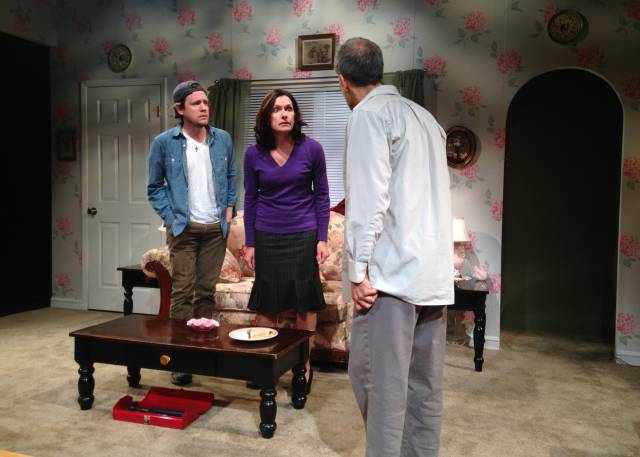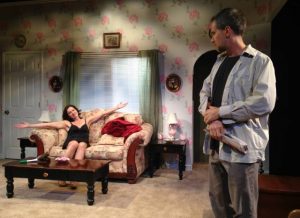

William Goulet is the writer/director of Filler, a serio-comedy about Marian and Adler, a married couple whose lives are irrevocably changed by the visit of two repairmen. The world premiere play opened Sunday at 64E4, and Mr. Goulet was kind enough to take time out of his busy schedule to talk about directing his own work, why he counts Beckett and Chekhov among his writing influences, and the "filler" article that prompted him to write this play.
How did you get your start in theatre?
When I was in high school I was on the football team. The coach made everyone go out for the musical because he wanted them to dance and get some agility, and I ended up playing Curly in “Oklahoma!” I wound up falling in love with the theatre.
Could you talk more about how you got into writing, specifically playwriting?
As an undergrad, I shifted from the drama department to the English department, and became fascinated with playwrights such as Chekhov and Beckett. I was also fascinated with the challenge of the limits of the theatrical medium, mainly using only dialogue to get the exposition, the plot line, the characters, etc. It was a challenge that I was already fascinated with, and it took me years to get the hang of it.
How did the idea/concept for Filler come about?
Years ago, I was out in California pursuing acting, and one day I came across a filler article that was so enigmatic and absurd to a certain degree. So I decided to make up my own filler article and to build a play around it. It was a very slow process—it started out as a much more bawdy comedy, and then I kept going into more serious notes, and kept getting pulled into the serio-comic element of the piece.
Just out of curiosity, what was the original filler article about?
It was about a man who had set fire to an Easter display, and then rushed to the scene to put it out in order to make himself look like a hero. However, someone had recorded him on a camera setting it on fire in the first place.
That’s hilarious. So what exactly is a filler article?
“Filler” is when you’ve got several columns with headlines and articles, and suddenly you find yourself in a little section, maybe down in the corner of the paper where there’s a blank space, so you just put a little article in there that doesn’t have much news value. They still exist today—they’re usually either feature articles or human interest stories.

I see. So in addition to writing Filler, you also directed it. What are some of the challenges of directing your own work?
Well first and foremost is the casting process. The first day of auditions is also the first day of directing, because you find people who are on the same page as you are in terms of the play—I auditioned some very good actors who didn’t click with the material, which can be a bit discouraging. You think “maybe it’s not very well written, and maybe that’s why these great actors aren’t clicking with the material”. But then I have people like Ross Pivec and Gabriele Schafer, who right off the bat knew what I was getting at. Then there’s always the fear of actors who are going into a production with a director who also wrote the play. The cast all voiced their misgivings upfront—they asked, “How much are you going to make us stick to what’s exactly inside your head?” My answer was, “As little as I possibly can.” I wasn’t trying to recreate specifically what was inside my head—I gave the actors a lot of freedom as long as they stayed within the parameters of the script, which are fairly broad, and open to interpretation. All of them were able to be as creative as possible. I wanted to be surprised, and I was, continuously. They worked very well as an ensemble to create these situations. However, I didn’t just sit there and watch it all happen—I would approach them as an actor, and suggest something, and have them try it out. Sometimes we agreed it worked and sometimes we didn’t. After we had finished blocking, we would go back to sections and inject more layers into them by trying new things, and eventually it just evolved into its own reality.
What sort of work did you put into developing the relationships between the characters in the play?
Well they had all read the play before rehearsals. Each actor has their own history for their characters. While some of them are very specific within text in the script, I was very open and let them start talking to each other. They then created a history for their characters. Whenever something came up that didn’t quite gel with what was in the context of the script, we would make adjustments. But together, and mostly on their own, they established and developed a history, which gave them something to feed off of. So we were able to keep that history in mind for every aspect, move, and advancement we made in the process. It was an ensemble process. In directing it, I was holding the picture together as it progressed, but I wanted to allow in my direction as much freedom as possible. One thing we did talk a lot about was the absurdist element of the piece—we discussed the fact that the story, the “filler” article and discussion of it, lent itself to an absurdist style of writing, but it isn’t necessarily absurd in itself. What is absurd is the filler article itself, and the discussion of it. However, it’s naturalistic because those kinds of articles really exist, as is the discussion about them, and the discussion can take some pretty absurd turns.
Who are your writing influences, if you have any while writing this piece?
I guess it wasn’t an accident that I mentioned Chekhov and Beckett earlier. I also like absurdist writers, such as Ionesco, and non-playwrights, such as Kafka and Dostoyevsky. While they’re all distinctly different, they have this elegant style. You end up loving the characters in that you feel for them to a great extent, and I think that also reflects my view of life, which is that anybody that’s trying to get through life without hurting anyone else inevitably does. But still, you try your best, like all my characters in this play. Marian still wants to help Adler, although she needs her own fulfillment. Adler wants to be brave in order to protect his wife, even though he finds it very difficult. This view of humanity is what I saw in Beckett and Chekhov. You know they’re trying to do their best, but they can’t help but look ridiculous.
Performances of Filler continue through November 30 at 64E4. For more information and tickets, visit https://fillertheplay.com/